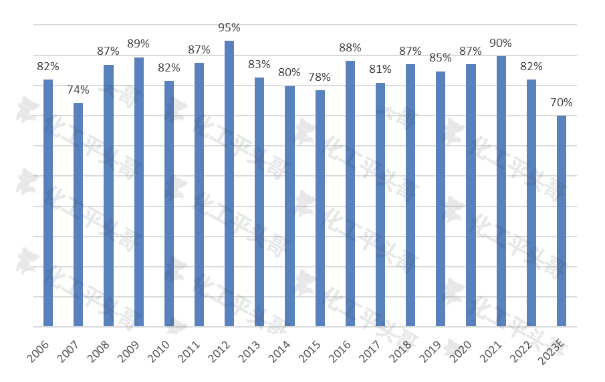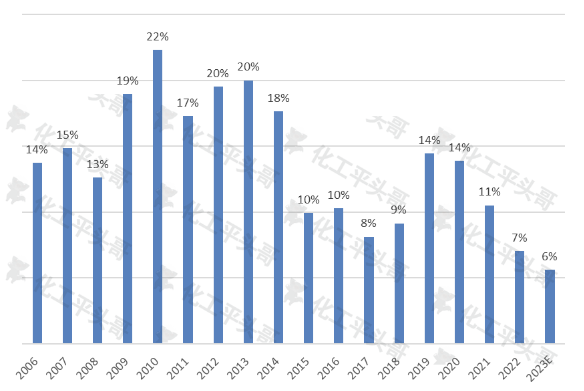1.Die vinnige groei van die epoksie-propaanbedryf
Epoksiepropaan, as 'n sleuteluitbreidingsrigting van stroomaf fyn chemikalieë in die propileenbedryfsketting, het ongekende aandag in die Chinese chemiese industrie gekry. Dit is hoofsaaklik te danke aan sy belangrike posisie in fyn chemikalieë en die ontwikkelingstendens wat teweeggebring word deur die industriële kettingverbinding van nuwe energieverwante produkte. Volgens statistiese data het die skaal van China se epoksiepropaanbedryf teen die einde van 2023 7,8 miljoen ton per jaar oorskry, wat byna tienvoudig toegeneem het in vergelyking met 2006. Van 2006 tot 2023 het die industriële skaal van epoksiepropaan in China 'n gemiddelde jaarlikse groeikoers van 13% getoon, wat skaars is in die chemiese industrie. Veral in die afgelope vier jaar het die gemiddelde groeikoers van die bedryfskaal 30% oorskry, wat 'n verstommende groeimomentum toon.
Figuur 1 Jaarlikse bedryfstempoveranderinge van epoksiepropaan in China
Agter hierdie vinnige groei is daar verskeie faktore wat dit dryf. Eerstens, as 'n belangrike stroomaf-uitbreiding van die propileenbedryfsketting, is epichlorohidrien die sleutel tot die bereiking van verfynde ontwikkeling in private ondernemings. Met die transformasie en opgradering van die plaaslike chemiese industrie, gee al hoe meer ondernemings aandag aan die veld van fyn chemikalieë, en epoksiepropaan, as 'n belangrike deel daarvan, het natuurlik wydverspreide aandag gekry. Tweedens, die ontwikkelingservaring van suksesvolle ondernemings soos Wanhua Chemical het 'n maatstaf vir die bedryf gestel, en hul suksesvolle industriële kettingintegrasie en innoverende ontwikkelingsmodelle bied verwysing vir ander ondernemings. Boonop, met die vinnige ontwikkeling van die nuwe energiebedryf, het die industriële kettingverbinding tussen epoksiepropaan en nuwe energieverwante produkte ook breë ontwikkelingsruimte gebring.
Hierdie vinnige groei het egter ook 'n reeks probleme meegebring. Eerstens het die vinnige uitbreiding van die bedryfskaal gelei tot toenemend ernstige teenstrydighede tussen vraag en aanbod. Alhoewel die markvraag na epoksiepropaan steeds groei, is die groeikoers van aanbod natuurlik vinniger, wat lei tot 'n voortdurende afname in die bedryfstempo van ondernemings en toenemend strawwe markmededinging. Tweedens is daar 'n ernstige verskynsel van homogene mededinging binne die bedryf. As gevolg van die gebrek aan kerntegnologie en innovasievermoëns, het baie ondernemings nie gedifferensieerde mededingende voordele in produkkwaliteit, prestasie en ander aspekte nie, en kan slegs deur prysoorloë en ander middele om markaandeel meeding. Dit beïnvloed nie net die winsgewendheid van ondernemings nie, maar beperk ook die gesonde ontwikkeling van die bedryf.
2.Die intensivering van teenstrydighede tussen vraag en aanbod
Met die vinnige uitbreiding van die epoksiepropaanbedryf word die teenstrydigheid tussen vraag en aanbod ook al hoe erger. In die afgelope 18 jaar was die gemiddelde bedryfstempo van epoksiepropaan in China ongeveer 85%, wat 'n relatief stabiele tendens handhaaf. Vanaf 2022 sal die bedryfstempo van epoksiepropaan egter geleidelik afneem, en daar word verwag dat dit teen 2023 tot ongeveer 70% sal daal, wat 'n historiese laagtepunt is. Hierdie verandering demonstreer ten volle die intensiteit van markmededinging en die intensivering van die teenstrydigheid tussen vraag en aanbod.
Daar is twee hoofredes vir die toenemende teenstrydighede tussen vraag en aanbod. Aan die een kant, met die vinnige uitbreiding van die bedryfskaal, betree al hoe meer ondernemings die epoksiepropaanmark, wat lei tot intensiewe markmededinging. Om vir markaandeel mee te ding, moet maatskappye pryse verlaag en produksie verhoog, wat lei tot 'n voortdurende afname in bedryfstempo's. Aan die ander kant is die stroomaf toepassingsgebiede van epoksiepropaan relatief beperk, hoofsaaklik gekonsentreer in die velde van poliëterpoliole, dimetielkarbonaat, propileenglikol en alkoholeters. Onder hulle is poliëterpoliole die belangrikste stroomaf toepassingsveld van epoksiepropaan, wat 80% of meer van die totale verbruik van epoksiepropaan uitmaak. Die verbruiksgroeikoers in hierdie veld is egter in ooreenstemming met die groeikoers van China se ekonomie, en die groei op industriële skaal is minder as 6%, wat aansienlik stadiger is as die groeikoers van die aanbod van epoksiepropaan. Dit beteken dat hoewel die markvraag groei, die groeikoers baie stadiger is as die groeikoers van die aanbod, wat lei tot die toenemende teenstrydighede tussen vraag en aanbod.
3.Die vermindering van invoerafhanklikheid
Invoerafhanklikheid is een van die hoofaanwysers vir die meting van die aanbodgaping in die binnelandse mark, en dit is ook 'n belangrike parameter wat die vlak van invoerskaal weerspieël. In die afgelope 18 jaar was die gemiddelde invoerafhanklikheid van China se epoksiepropaan ongeveer 14% en het 'n piek van 22% bereik. Met die vinnige ontwikkeling van die binnelandse epoksiepropaanbedryf en die voortdurende toename in binnelandse skaal, het die invoerafhanklikheid egter jaar na jaar 'n afnemende neiging getoon. Daar word verwag dat China se invoerafhanklikheid van epoksiepropaan teen 2023 tot ongeveer 6% sal daal en 'n historiese laagtepunt in die afgelope 18 jaar sal bereik.
Figuur 2 Tendens van China se afhanklikheid van ingevoerde epoksiepropaan
Die afname in invoerafhanklikheid is hoofsaaklik te wyte aan twee faktore. Eerstens, met die vinnige uitbreiding van die plaaslike epoksiepropaanbedryf, is die gehalte en prestasie van plaaslike produkte aansienlik verbeter. Baie plaaslike ondernemings het beduidende deurbrake in tegnologiese innovasie en produknavorsing en -ontwikkeling gemaak, wat daartoe gelei het dat die gehalte van plaaslike vervaardigde epoksiepropaan amper dieselfde is as ingevoerde produkte. Dit het plaaslike ondernemings 'n groter mededingende voordeel in die mark gegee en hul afhanklikheid van ingevoerde produkte verminder. Tweedens, met die voortdurende toename in plaaslike epoksiepropaanproduksiekapasiteit, is die markvoorsieningskapasiteit aansienlik verbeter. Dit stel plaaslike ondernemings in staat om beter aan die markvraag te voldoen en die vraag na ingevoerde produkte te verminder.
Die afname in invoerafhanklikheid het egter ook 'n reeks probleme meegebring. Eerstens, met die voortdurende uitbreiding van die binnelandse epoksiepropaanmark en die voortdurende groei in vraag, neem die aanboddruk van binnelandse produkte ook toe. As binnelandse ondernemings nie in staat is om produksie en kwaliteit verder te verhoog nie, kan die teenstrydigheid tussen vraag en aanbod op die mark verder vererger. Tweedens, met die afname in invoerafhanklikheid, staar binnelandse ondernemings groter markmededingingsdruk in die gesig. Om mee te ding vir markaandeel en mededingendheid te handhaaf, moet binnelandse ondernemings hul tegnologiese vlak en innovasievermoëns voortdurend verbeter.
4.Analise van toekomstige ontwikkelingsituasie
Die Chinese epoksiepropaanmark sal in die toekoms 'n reeks diepgaande veranderinge in die gesig staar. Volgens statistiese data word verwag dat die omvang van China se epoksiepropaanbedryf teen 2030 meer as 14 miljoen ton/jaar sal wees, en die gemiddelde jaarlikse groeikoers sal van 2023 tot 2030 op 'n hoë vlak van 8,8% bly. Hierdie vinnige groeikoers sal ongetwyfeld die aanboddruk op die mark verder vererger en die risiko van oorkapasiteit verhoog.
Die bedryfstempo van 'n bedryf word dikwels beskou as 'n belangrike aanwyser om te evalueer of die mark surplus is. Wanneer die bedryfstempo onder 75% is, kan daar 'n oormaat in die mark wees. Die bedryfstempo word direk beïnvloed deur die groeikoers van die terminale verbruikersmark. Tans is die hoof stroomaf toepassingsveld van epoksipropaan poliëterpoliole, wat meer as 80% van die totale verbruik uitmaak. Ander toepassingsgebiede soos dimetielkarbonaat, propileenglikol en alkoholeter, vlamvertragers, hoewel teenwoordig, het egter 'n relatief klein proporsie en beperkte ondersteuning vir die verbruik van epichlorohidrien.
Dit is opmerklik dat die verbruiksgroeikoers van poliëterpoliole basies ooreenstem met die groeikoers van China se ekonomie, en die groei op industriële skaal is minder as 6%, aansienlik laer as die aanbodgroeikoers van epoksiepropaan. Dit beteken dat terwyl die groeikoers aan die verbruikerskant relatief stadig is, die vinnige groei aan die aanbodkant die vraag- en aanbodomgewing van die epoksiepropaanmark verder sal versleg. Trouens, 2023 mag reeds die eerste jaar van ooraanbod in China se epoksiepropaanbedryf wees, en die waarskynlikheid van ooraanbod op die lang termyn bly hoog.
Epoksiepropaan, as 'n oorgangsproduk in die vinnige ontwikkeling van China se chemiese industrie, het sy unieke eienskappe. Dit vereis dat produkte die eienskappe van homogeniteit en skaal moet hê, terwyl dit relatief lae beleggings- en tegnologiese hindernisse het, en maklike toegang tot grondstowwe. Daarbenewens moet dit ook middelreeks-eienskappe in die industriële ketting hê, wat beteken dat dit stroomaf uitbreiding van die industriële ketting kan bereik. Hierdie tipe produkte speel 'n belangrike rol in die verfyn ontwikkeling van die chemiese industrie, maar staar ook die risiko van markhomogeniseringskokke in die gesig.
Daarom, vir ondernemings wat epoksiepropaan produseer, sal hoe om differensiasie in die ontwikkeling van die industriële ketting in strawwe markkompetisie te soek en hoe om meer gevorderde tegnologie te gebruik om produksiekoste te verminder, belangrike strategiese oorwegings vir hul toekomstige ontwikkeling word.
Plasingstyd: 28 Februarie 2024






